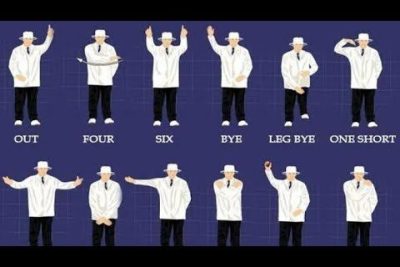Cricket, often regarded as a gentleman’s game, relies heavily on the expertise of umpires to maintain fair play and uphold the spirit of the sport. One integral aspect of their role is the use of hand signals, which serve as a universal language to communicate decisions and relay information to players and spectators alike. From signaling boundaries to declaring dismissals, these common hand gestures are not only essential to the smooth functioning of a match but also add a touch of elegance and intrigue to the game. In this article, we delve into the world of cricket umpiring, exploring the meaning and significance behind these captivating hand signals that captivate fans worldwide.
What are the hand signals used by umpires?
Umpires employ a range of hand signals to indicate a strike, all executed with their right hand. These signals vary between umpires, with each official developing their own personalized system. While some opt for the traditional clenched fist to denote a strike, others prefer an open hand extended outwards. Furthermore, there are variations in body positioning, as some umpires face forward while others turn. Moreover, the timing of the signal differs, with some umpires calling the strike before signaling, while others perform both actions simultaneously.
How can one indicate four byes in the game of cricket?
In cricket, a bye is awarded when a bowled ball does not make contact with the bat or the batsman’s body as it passes the stumps. The number of byes scored corresponds to the runs taken during that play. To signal four byes, the umpire raises one arm high above their body, creating a clear and distinctive visual cue for both players and spectators alike.
With a legal delivery that misses the bat and the batsman’s body, cricket grants a bye. The number of byes scored reflects the runs acquired during the play. To signify the accumulation of four byes, the umpire extends one arm high above their body, forming a striking and easily recognizable gesture that leaves no room for ambiguity.
How are 6 runs signaled by umpires?
When a batter scores six runs in cricket, umpires have a distinctive and captivating way of signaling it. With utmost precision and flair, they extend both arms together in a synchronized movement, reaching for the sky. This eye-catching gesture immediately captures the attention of players and spectators alike, leaving no doubt about the remarkable achievement on the field.
In the realm of cricket, the signal for six runs is a visual spectacle. Umpires raise both arms in unison, creating a powerful image that signifies the batter’s incredible feat. With arms extended vertically in the air, the umpires convey the momentousness of this scoring milestone, drawing all eyes to the exceptional performance unfolding before them.
Master the Art of Communication: Unveiling Cricket’s Hand Signals
Master the Art of Communication: Unveiling Cricket’s Hand Signals
In the fast-paced world of cricket, where split-second decisions can make or break a game, effective communication is key. While verbal cues are essential, cricket teams have also developed a sophisticated system of hand signals to convey messages discreetly and swiftly. These hand signals, executed with precision and finesse, allow players to communicate strategies, tactics, and warnings without alerting the opposing team. From signaling a change in bowling tactics to coordinating intricate field placements, mastering these subtle gestures is a crucial skill for any cricketer looking to excel on the field.
Cricket’s hand signals are a visual symphony, a language understood only by those initiated into the sport. Each gesture carries a specific meaning, allowing players to convey complex instructions without uttering a single word. Whether it’s signaling a quick single or indicating a fielder’s position, these gestures can be executed swiftly, minimizing the risk of miscommunication. Just like a secret code, cricket’s hand signals add an element of intrigue and strategy to the game, captivating both players and spectators alike. So, if you aspire to become a cricket maestro, mastering these elegant hand signals is a must, for they hold the power to unlock a whole new level of communication on the field.
Decode the Game: A Visual Handbook for Cricket Umpires
Decode the Game: A Visual Handbook for Cricket Umpires
1. In the fast-paced world of cricket, umpires play a crucial role in ensuring fair play and upholding the rules of the game. However, with complex regulations and ever-evolving game strategies, the role of an umpire can be challenging. “Decode the Game: A Visual Handbook for Cricket Umpires” is the ultimate guide designed to provide umpires with clear, concise, and visually engaging information to enhance their decision-making skills on the field.
2. This comprehensive handbook is packed with easy-to-understand diagrams, illustrations, and step-by-step instructions, making it an indispensable resource for both aspiring and seasoned cricket umpires. From understanding the different types of dismissals to interpreting signals and gestures, each section is thoughtfully curated to decode the intricacies of the game. With its visually appealing layout, this handbook ensures that umpires can quickly access the information they need during high-pressure situations.
3. From the moment they step onto the field, umpires need to be confident and well-prepared. “Decode the Game” equips umpires with the knowledge and skills required to make accurate decisions, handle contentious situations, and maintain the integrity of the game. Whether it’s a close LBW call or determining if a catch is legitimate, this visual handbook empowers umpires to decode the game with precision, ensuring a fair and exciting cricketing experience for players and spectators alike.
Speak Without Words: The Ultimate Guide to Cricket Umpiring Signals
Speak Without Words: The Ultimate Guide to Cricket Umpiring Signals
In the fast-paced game of cricket, where split-second decisions can make or break a match, umpiring signals serve as a silent language that speaks volumes. With a simple raise of the finger, an umpire can convey to the players, spectators, and fellow officials whether a batsman is out or not. From the classic out signal to the dramatic boundary signal, these gestures are not only concise and clean but also eye-catching, ensuring clarity and avoiding any confusion on the field. Whether it’s signaling a wide, a no-ball, or a bye, a skilled umpire knows how to effortlessly communicate with precision, leaving no room for doubt. So, next time you watch a cricket match, pay close attention to the umpire’s gestures, for they tell a story that words cannot.
In the fast-paced game of cricket, effective communication between players and umpires is essential. Hand signals play a crucial role in conveying decisions and information on the field. From the iconic raised finger for an out to the elaborate arm movements for a boundary, these gestures not only facilitate smooth gameplay but also add an element of visual drama to the sport. So, the next time you find yourself engrossed in a cricket match, take a moment to appreciate the skill and precision behind the common hand signals that keep the game running smoothly.


